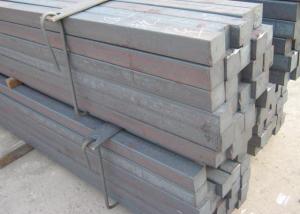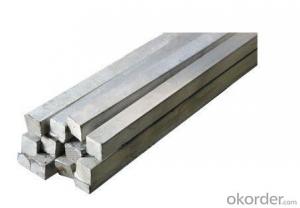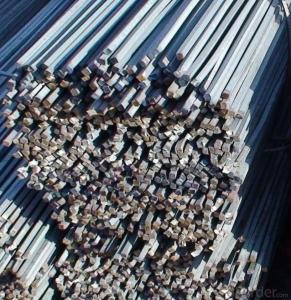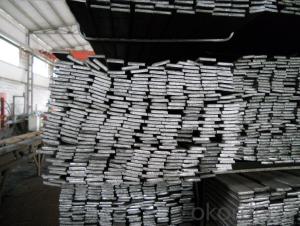High Quality GB Standard Steel Square Bar 7mm-10mm
- Loading Port:
- Tianjin
- Payment Terms:
- TT OR LC
- Min Order Qty:
- 25 m.t
- Supply Capability:
- 10000 m.t/month
OKorder Service Pledge
OKorder Financial Service
You Might Also Like
Product Description:
-Standard: GB,
-Grade: Q195 or equivalent.
-Chemical Composition:
Standard | Grade | Element (%) | ||||
GB | Q195 | C | Mn | S | P | Si |
0.06~0.12 | 0.25~0.50 | ≤0.050 | ≤0.045 | ≤0.30 | ||
Measures of HR Square Bar (small measures):

(Section of HR Square Bar)
-Length of a side and Theoretical weight of Square Bar.
Length of a side(mm) | Theoretical weight(kg/m) | Length of a side(mm) | Theoretical weight(kg/m) |
7 | 0.385 | 22 | 3.80 |
8 | 0.502 | 24 | 4.52 |
9 | 0.636 | 25 | 4.91 |
10 | 0.785 | 26 | 5.30 |
11 | 0.950 | 28 | 6.15 |
12 | 1.13 | 30 | 7.06 |
13 | 1.33 | 32 | 8.04 |
14 | 1.54 | 34 | 9.07 |
15 | 1.77 | 36 | 10.17 |
16 | 2.01 | 38 | 11.24 |
17 | 2.27 | 40 | 12.56 |
18 | 2.54 | 42 | 13.85 |
19 | 2.82 | 45 | 15.90 |
20 | 3.14 | 48 | 18.09 |
21 | 3.46 | 50 | 19.63 |
Notes:
1, The theoretical weights in the list, base on the density of 7.85 g/cm3.
2, Formula for theoretical weight of Square bar: (length of a side)2 * 0.00785
3, The numbers with *mean that they are not regular or we don’t offer them.
-Regular length of Square Bar:
Steel | Length of a side (mm) | Length of steel (m) |
Normal steel | < 25 | 4~10 |
> 25 | 3~9 | |
Steel of high quality | All measure | 2~6 |
Tool steel >75 | 1~6 |
Usage/Applications of HR Square Bar:
-The Square Bar is normally used as structure steel.
-Row material for other structure steel like steel angles, channels, I-beams, H-beams, etc…
Packaging & Delivery of HR Square Bar:
-Packing Detail: The products can be packed in bundles by steel wires.
-Marks: We make tag marks and color marks. The tag marks with white background and red company logo will be tied up to each bundle of the products. The information is usually including basic information of products and company and other information requested by customers. As for color marks, we will paint both ends of bundles to make sure that it will be more convenient for customers to distinguish them from other products.
-Delivery Detail: 30~45 working days after receive buyer’s T.T. or L/C.
Transportation:
-The products can be delivered by bulk vessel or by container. As for container, products with the length of 6m will be loaded in 20’ container, with 9m or 12m, in 40’ container.
-The maximum quantity of loading of container is 25 tons.
-The products are usually transported to the nearest port from the production place.
- Q: Can a steel square be used for checking the alignment of a jointer fence?
- Yes, a steel square can be used for checking the alignment of a jointer fence.
- Q: How do you use a steel square to find the length of a board?
- To use a steel square to find the length of a board, follow these steps: 1. Begin by placing the steel square against one end of the board, ensuring that it is aligned properly with the edge. 2. Hold the steel square firmly in place, making sure it doesn't move during the measurements. 3. Look at the long side of the steel square, which is often referred to as the blade. It will have measurements marked on it. 4. Locate the inch markings on the blade and find the line that corresponds to the width of the board. For example, if the board is 6 inches wide, find the line labeled "6". 5. Once you have found the correct line, look at the short side of the steel square, called the tongue. It will have measurements marked on it as well. 6. Align the tongue with the edge of the board, ensuring that it is flush against the side. 7. While keeping the steel square and tongue in place against the board, extend the blade along the length of the board. 8. Now, observe the measurement marked on the blade where it aligns with the opposite end of the board. This measurement indicates the length of the board. 9. Take note of the measurement or use a pencil to mark it on the board for future reference. By using a steel square in this manner, you can accurately determine the length of a board, providing you with the necessary information for your woodworking or construction project.
- Q: Can a steel square be used for laying out a patio?
- Yes, a steel square can be used for laying out a patio. A steel square is a versatile tool that can be used to measure right angles and ensure accurate and square corners during the patio layout process. It can help in aligning and positioning the patio pavers or stones, resulting in a well-designed and level patio surface.
- Q: Are there any safety precautions to consider when using a steel square?
- There are a number of safety precautions to bear in mind when using a steel square: 1. It is important to wear the appropriate personal protective equipment (PPE), such as safety glasses, gloves, and a dust mask, to safeguard against potential injuries or inhaling dust or debris. 2. The steel square should be checked for any defects or damage to ensure it is in good condition. Using a damaged or warped square can compromise the accuracy of measurements and could potentially lead to accidents. 3. Always handle the steel square with care and avoid dropping it. Dropping a heavy steel tool can result in foot injuries or damage to the surrounding area. 4. When using the square for cutting or sawing, ensure that the material being cut is securely fastened to prevent movement or slipping during the process. This will help avoid accidents and ensure precise cuts. 5. Be cautious of sharp edges or corners on the steel square and refrain from running your hands or fingers along them to prevent cuts or lacerations. 6. When not in use, store the steel square in a safe and secure location. This will prevent accidental tripping or falling hazards and help maintain the tool's condition. By adhering to these safety precautions, one can minimize the risk of accidents and ensure the safe utilization of a steel square.
- Q: How do you use a steel square to measure and mark irregular angles?
- In order to measure and mark irregular angles using a steel square, there are several steps to follow. Begin by positioning the steel square against the angle you wish to measure, ensuring that one edge of the square aligns with one side of the angle. Proceed by firmly holding the square in place to secure it against the angle. Once the square is secure, observe the markings on the body of the square. These markings typically display degrees or angles, allowing for precise angle measurement. Align the appropriate marking on the square with the other side of the angle and take note of the measurement. To mark the irregular angle, a pencil or scribe tool can be utilized. Align the square with the angle, aligning the desired measurement with the other side of the angle. With the square in position, use the pencil or scribe tool to mark the angle on the material being worked on. It is important to maintain a steady hold on the square while marking to ensure accuracy. In the case of particularly complex or irregular angles, additional tools or techniques may be necessary for accurate measurement and marking. In such instances, seeking professional guidance or consulting specific resources on measuring irregular angles can be beneficial.
- Q: How do you use a steel square to determine the slope of a deck?
- To determine the slope of a deck using a steel square, you can place one leg of the square on the deck surface and the other leg against a vertical post or wall. By adjusting the square until both legs are level, you can then read the degree markings on the square to determine the slope of the deck.
- Q: How do you use a steel square to measure and mark 219.375-degree angles?
- To measure and mark a 219.375-degree angle using a steel square, you would first align the long edge of the square with the reference line or edge. Then, locate the degree markings on the square's blade and find the 180-degree mark. From there, move along the blade towards the handle until you reach the 39.375-degree mark. Finally, align a straight edge or pencil with this mark and draw a line to mark the desired angle.
- Q: Can a steel square be used for marking out mortises?
- Yes, a steel square can be used for marking out mortises. The square's straight edges and right angles make it a useful tool for accurately measuring and marking the dimensions of a mortise on a piece of wood.
- Q: How do you use a steel square to determine the length of a pipe cut?
- To use a steel square to determine the length of a pipe cut, you would first place the steel square against the pipe, ensuring that one side of the square aligns with the edge of the pipe. Then, you would mark the desired length on the pipe using the other side of the square as a guide. Finally, you can use a cutting tool, such as a pipe cutter or hacksaw, to make the cut at the marked point.
- Q: Can a steel square be used for checking the squareness of a table saw blade?
- Using a steel square to check the squareness of a table saw blade is not recommended. Although a steel square is useful for measuring right angles and checking the squareness of different objects, it is not designed to accurately measure the squareness of a rotating saw blade. To ensure the table saw blade is square, it is advised to utilize specialized tools such as a dial indicator or a square gauge specifically designed for table saws. These tools offer precise measurements and can be calibrated to accurately check the squareness of the blade. They are specifically designed to handle the rotational movement of the blade and provide accurate readings. Incorrectly using a tool like a steel square may lead to inaccurate measurements, which can result in improper cuts and compromised woodworking projects. Therefore, it is crucial to follow the manufacturer's recommendations and employ appropriate tools and techniques to ensure the table saw blade is properly aligned and square.
Send your message to us
High Quality GB Standard Steel Square Bar 7mm-10mm
- Loading Port:
- Tianjin
- Payment Terms:
- TT OR LC
- Min Order Qty:
- 25 m.t
- Supply Capability:
- 10000 m.t/month
OKorder Service Pledge
OKorder Financial Service
Similar products
Hot products
Hot Searches
Related keywords




























